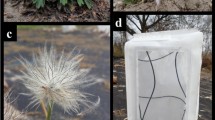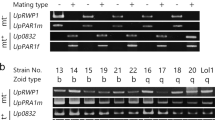Abstract
THE pollen grains of certain liliaceous plants, for example Hyacinthus and Ornithogalum are known to give rise to embryo sac-like structures1. During the course of a study of the embryology of Leptomeria acida, L. cunninghamii and L. billardierii (Santa-laceæ), I came across embryo sac-like structures arising directly from the microspore mother cells in the last named species—a phenomenon which is probably not yet recorded in any other angiosperm. Besides the microtome sections, acetocarmine squashes proved very useful for obtaining complete views of the ‘embryo sacs’.
This is a preview of subscription content, access via your institution
Access options
Subscribe to this journal
Receive 51 print issues and online access
$199.00 per year
only $3.90 per issue
Buy this article
- Purchase on Springer Link
- Instant access to full article PDF
Prices may be subject to local taxes which are calculated during checkout
Similar content being viewed by others
References
Némec, B., Rozpr. ceske. Akad. Prag., II, 7 (17) (1898).
De Mol, W. E., Genetica, 5, 225 (1923).
Stow, I., Cytologia, 5, 88 (1934).
Naithani, S. P., Ann. Bot., 1, 369 (1937).
Geitler, L., Ber. dtsch. bot. Ges., 59, 419 (1941).
Author information
Authors and Affiliations
Rights and permissions
About this article
Cite this article
RAM, M. Occurrence of Embryo Sac-like Structures in the Microsporangia of Leptomeria billardierii R.Br.. Nature 184, 914–915 (1959). https://doi.org/10.1038/184914a0
Issue Date:
DOI: https://doi.org/10.1038/184914a0
This article is cited by
-
Experimental androgenesis in plants—A review
Proceedings / Indian Academy of Sciences (1977)
-
In vivo embryoids from anthers of Narcissus biflorus Curt
Euphytica (1977)
-
The origin and in vivo development of embryoids in the anthers of Solanum hybrids
Euphytica (1974)
Comments
By submitting a comment you agree to abide by our Terms and Community Guidelines. If you find something abusive or that does not comply with our terms or guidelines please flag it as inappropriate.



